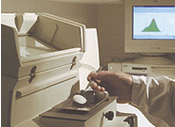|
Responsible, Accountable, and Sustainable
We take our responsibility to our clients very seriously. All our internal laboratory, manufacturing and distribution processes are strictly defined, closely monitored and carefully recorded. We set highly standards of cleanliness, traceability and environmental accountability for our processes and products. We operate not only according to our own internal safety and quality controls, but also according to international standards.The kind of quality that SHENGMA offers extends beyond ingredients and products that are simply superior. We canalso meet the needs of customers whose definition of quality goes further, to include highly specific requirements such as Organic, non-GMO or Kosher because we believe that quality should be measured by meeting your standards, not just our own.
The company the full set Analyzing Equipments & System to ensured complete control of its products right from the production of raw material (herbs and the chemicals) to the final dried and packing, and to guarantee of full traceability and high quality ingredients:
-
Equipped with Hi-Tech Instruments like HPLC (High Performance Liquid Chromatography), UV (Visible Spectrophotometer), GC (Gas Chromatography), TLC (Thin Layer Chromatography), Head Space Analyzer, Polarimeter, Auto Titrator, Mettler Balance, Water
|
|
Analyzer & pH meters etc.
Highly Qualified & Experienced Personnel guide the Analysts, and periodic Intensive training programs.
Quality Assurance through built-in system of procedures, checks and adequate documentation.
Control and Assurance of Quality of Raw materials through Intermediate to Final Product.
In-House, Customer and Pharmacopoeia Specifications are strictly enforced.
Development and Validation of Analytical Methods.
Control Samples maintenance.
Adequate Documentation and Storage System to demonstrate the system capability and traceability.
High Performance Liquid Chromatography (HPLC)
HPLC is a very powerful analytical tool which selectively measures chemical constituents, whether active or marker compounds such as Flavonoids, Polyphenols, and Alkaloids. A fingerprint or botanical profile is generated to insure that all constituents are present in the proper ratio.
Thin Layer Chromatography (TLC)
This is a separation technique used to verify the presence of actives and constituents in herbs and botanicals. The botanical in question is separated into its unique chemical spectrum-represented in colored bands, known as a chromatogram. Each band in the chromatogram represents an active or constituent. For proper identification, the chromatogram is then compared to that of a standard, as well as to a previously established reference for that particular botanical.
Fourier Transform Infrared Spectroscopy (FTIR)
This is an analytical spectroscopic technique that utilizes infrared radiation to provide functional information about our botanicals. For each botanical, the spectra record displays the absorption characteristics of functional groups, particularly in the fingerprint region, a singular marker area in each compound. For identification purposes, the spectrum of the botanical in question is overlaid with an established IR spectrum for that particular species.
Microscopic Image Analysis
With the pioneering use of a phase contrast microscope (up to 2000x) digitally linked to our computer system, we have built a unique microscopic digital image reference database for most herbs we provide to our customers. We are the only botanicals supplier performing this test for our customers. This authentication system enables us to analyze the microscopic features of the plant species, instantly uncovering adulterations. We have also developed a unique microscopic reference image database for each botanical species.
Organoleptic Testing
Our taste experts make a brew of the herb, not unlike making tea, then compare the color, taste, and aroma with an established standard.
Macroscopic Taxonomy
Macroscopic analysis of botanical products involved identifying a particular botanical according to the unique features it possesses. These features include the color and texture of a piece of root, or the size and shape of a leaf. Details such as the way a piece of wood fractures, the size of the pith, and the arrangement of roots. Size and shape of seeds, presence of trichombs or spines, and color and design of flowers are characteristics used to positively identify herbs. A benefit to macroscopic analysis is the ability to identify the presence of foreign botanicals or adulterants. These include the presence of other plants, plant parts, mold, algae, moss, or lichens. Macroscopic analysis is a primary step in assuring the quality of our botanical products.
|


